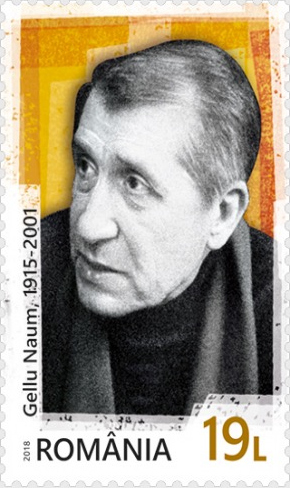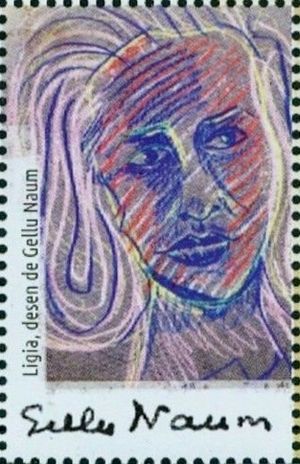Gellu Naum facts for kids
Gellu Naum (born August 1, 1915 – died September 29, 2001) was a very important Romanian writer. He was a poet, wrote plays, novels, and books for children. He also translated many books into Romanian. Gellu Naum is best known for starting the Surrealist group in Romania. His wife, Lygia Naum, was a painter and the main character in his 1985 novel, Zenobia.
Contents
About His Life
Early Years and Education
Gellu Naum was born in Bucharest, the capital city of Romania. His father, Andrei Naum, was also a poet. Sadly, his father died during World War I.
In 1933, Gellu Naum started studying philosophy at the University of Bucharest. Later, in 1938, he moved to France. There, he continued his studies at the University of Paris. He even earned a special degree for his work on a philosopher named Pierre Abelard.
Surrealism and War Experiences
In 1936, Gellu Naum met Victor Brauner, who became a good friend. Brauner later introduced Naum to André Breton and his group of Surrealist artists in Paris. Surrealism was a movement in art and literature that explored dreams and the imagination.
In 1941, Naum helped create the Surrealist group in Bucharest. Other members included Gherasim Luca and Paul Păun. During World War II, Naum joined the Romanian Army. He served on the Eastern Front after the invasion of the Soviet Union. His experiences during the war were very difficult. He became ill and was discharged from the army in 1944.
Life After the War
After World War II, Romania came under a new government. This new government had strict rules about what artists could create. They preferred a style called Socialist realism. Because of these rules, Gellu Naum could mostly publish books for children. His two books about a penguin named Apolodor became very popular and were printed many times.
Even though he published some books in the approved style, he never stopped writing Surrealist poems. Some of these poems, like Heraclitus, were published later. An older manuscript, The Way of the Snake, was published after he passed away.
Between 1950 and 1953, Gellu Naum taught philosophy at a university in Bucharest. He also worked as a translator. He translated books by many famous writers. These included Samuel Beckett, Franz Kafka, Victor Hugo, and Jules Verne.
Later Career and Travels
In 1968, there was a period of more cultural freedom in Romania. This allowed Gellu Naum to publish his literary works again.
After the Romanian Revolution of 1989, he traveled outside Romania. He gave public readings of his works in countries like France, Germany, and Switzerland. In 1995, he was invited to be a scholar at the University of Berlin. Gellu Naum spent his last years in a quiet place called Comana.
His Books
Here are some of the books Gellu Naum wrote:
- Drumeţul incendiar ("The Incendiary Traveler"; poems), Bucharest, 1936
- Vasco de Gama, (poem), Bucharest, 1940
- Culoarul somnului, ("The Corridor of Sleep"; poems), Bucharest, 1944
- Medium (prose), Bucharest, 1945
- Critica mizeriei ("Critique of Misery"; manifesto, with Paul Păun and Virgil Teodorescu), Bucharest, 1945
- Teribilul interzis ("The Terrible Forbidden"; drama), Bucharest, 1945
- Spectrul longevităţii: 122 de cadavre ("The Specter of Longevity: 122 corpses"; drama, with Virgil Teodorescu), Bucharest, 1946
- Castelul Orbilor ("Castle of the Blind"; drama), Bucharest, 1946
- L'infra-noir ("Infra-Black"; manifesto, with Gherasim Luca, Paul Păun, Virgil Teodorescu, and Dolfi Trost), Bucharest, 1947
- Éloge de Malombra – Cerne de l'amour absolu ("Malombra's Eulogy – Black Circle of Absolute Love"; manifesto, with Gherasim Luca, Paul Păun, and Dolfi Trost), Bucharest, 1947
- Filonul, Bucharest, 1952 ("The Vein"; prose)
- Tabăra din munţi, Bucharest, 1953 ("The Camp in the Mountains"; prose)
- Aşa-i Sanda, Bucharest, 1956 ("So Is Sanda"; poems for children)
- Cartea cu Apolodor, Bucharest, 1959 ("The Book With Apolodor"; poems for children)
- Poem despre tinereţea noastră, Bucharest, 1960 ("Poem About Our Youth"; poems)
- Soarele calm, Bucharest, 1961 ("The Calm Sun"; poems)
- A doua carte cu Apolodor, Bucharest, 1964 ("The Second Book With Apolodor"; poems for children)
- Athanor (poems), Bucharest, 1968
- Poetizaţi, poetizaţi... ("Poeticize, Poeticize..."; prose), Bucharest, 1970
- Copacul-animal ("The Animal-Tree"; poems), Bucharest, 1971
- Tatăl meu obosit ("My Tired Father"; poems), Bucharest, 1972
- Poeme alese ("Selected Poems"; poems), Bucharest, 1974
- Cărţile cu Apolodor ("The Apolodor Books", poems for children), Bucharest, 1975
- Descrierea turnului ("Description of the Tower"; poems), Bucharest, 1975
- Insula. Ceasornicăria Taus. Poate Eleonora ("The Island. The Taus Clockmakers. Eleonora, Perhaps"; drama), Bucharest, 1979
- Partea cealaltă ("The Other Side"; poems), Bucharest, 1980
- Zenobia (novel), Bucharest, 1985
- Amedeu, cel mai cumsecade leu, Bucharest, 1988 ("Amedeu, The Most Honest Lion"; poems for children)
- Apolodor, un mic pinguin călător, Bucharest, 1988 ("Apolodor, A Small Travelling Penguin"; poems for children)
- Malul albastru ("The Blue Shore; prose), Bucharest, 1990
- Faţa şi suprafaţa, urmat de Malul albastru ("Face and Surface, followed by The Blue Shore", poems), Bucharest, 1994
- Focul negru ("Black Fire"; poems), Bucharest, 1995
- Sora fântână ("Sister Fountain"; poems), Bucharest, 1995
- Întrebătorul ("The Inquirer"; prose), Bucharest, 1996
- Copacul-animal, urmat de Avantajul vertebrelor ("The Animal-Tree, followed by The Advantage of Vertebrae"), Cluj-Napoca, 2000
- Ascet la baraca de tir ("Recluse in the Firing Range Shack"; poems), Bucharest, 2000
- Calea şearpelui ("The Way of the Snake"), Bucharest, 2002 (published after his death)
See also
 In Spanish: Gellu Naum para niños
In Spanish: Gellu Naum para niños



